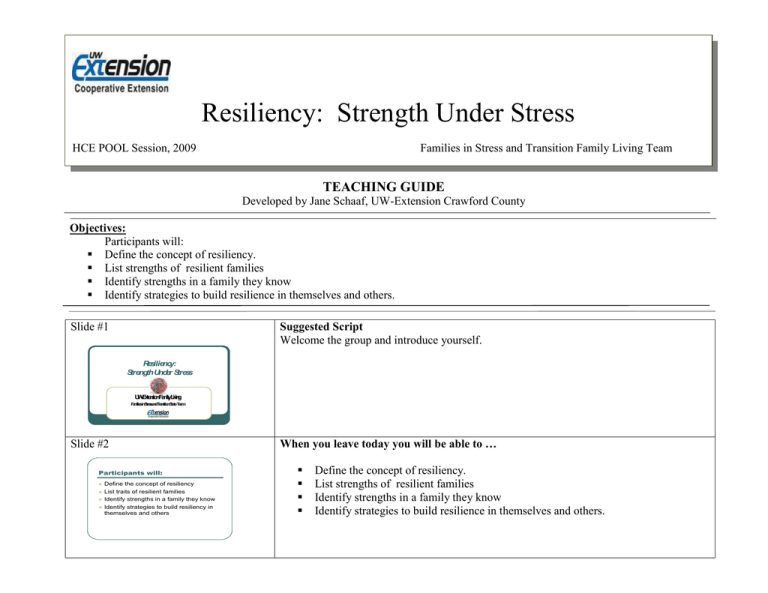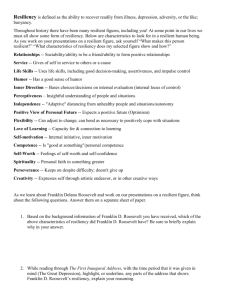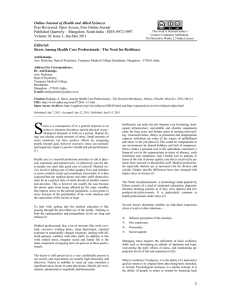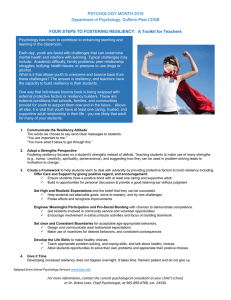Family Resiliency Teaching Unit
advertisement

Resiliency: Strength Under Stress HCE POOL Session, 2009 Families in Stress and Transition Family Living Team TEACHING GUIDE Developed by Jane Schaaf, UW-Extension Crawford County Objectives: Participants will: Define the concept of resiliency. List strengths of resilient families Identify strengths in a family they know Identify strategies to build resilience in themselves and others. Slide #1 Suggested Script Welcome the group and introduce yourself. Resiliency: Strength Under Stress UW -ExtensionFam ilyLiving Fam iliesinStressandTransitionStateTeam Slide #2 Participants will: Define the concept of resiliency List traits of resilient families Identify strengths in a family they know Identify strategies to build resiliency in themselves and others When you leave today you will be able to … Define the concept of resiliency. List strengths of resilient families Identify strengths in a family they know Identify strategies to build resilience in themselves and others. Slide # 3 We all have difficult times Slide #3 No one ever said life would be easy! Slide #4 Slide # 4 Families experience stress What are some typical, predictable sources of stress in family life across the age span? What might be an unexpected crisis? Discuss: If we look at the life span of an individual or the life stages of a family, there are some typical, predictable times of stress and change. Certainly the birth of a baby affects a family. Graduating from high school affects an individual and a family. What are some other examples of normal stresses across the lifespan? Individuals and families also face unexpected stress-such as a job loss. What are some other unexpected stressors that can really throw people for a loop? After the discussion, show slide # 5 Slide #5 Stress comes from many sources Normal changes in our lives Unexpected events • • e.g., leaving home; birth of a child; getting older Slide # 5 Stress comes from many sources: normal changes in our lives; unexpected events; developments in the world around us. Note that sometimes even a good thing (like winning the lottery!) can cause stress e.g., death of a loved one, job loss, severe illness, winning the lottery. Developments in the world around us • e.g., poverty, crime, school violence, social and political trends Activity: Give each participant a toothpick and a rubber band. Ask them to bend the toothpick as far as they can. Eventually the toothpick will break. Then ask the participants to stretch the rubber band as far as they can. The rubber band will probably not break. In fact if they let go, the rubber band will probably move forward. (You could choose to do the activity with everyone or you can demonstrate it yourself). Slide # 6 2 Resiliency is the ability to Not only survive, but thrive! In order to remain strong, we must stretch ourselves and spring forward! Slide #7 Definitions of resiliency “The path a family follows as it adapts and prospers in the face of stress.” (Hawley and DeHaan, 2003) “Capacity to cultivate strengths to positively meet the challenges of life.” (Silliman, 1994) “Ability to bounce back from adversity” (Stuart, 2004) “Capacity to rebound from adversity strengthened and more resourceful” (Walsh,1998) Slide # 8 What helps you be strong under stress? Think back to a rough time in your own life. What did you do that helped? (For example, talked to friends,) Now think about that rough time and identify what qualities were helpful in keeping you resilient. (For example, a Slide # 6 Resiliency is the ability to not only survive, but thrive. In order to remain strong, we must stretch ourselves and spring forward. In order for a rubber band to move forward, we need to pull it back first. That same thing happens in life. Something can happen that knocks us back for awhile. We just don’t want to get stuck there! We may fall back, but then look out-we’re moving forward, stronger than ever! Slide # 7 There are many ways to define resiliency. Here are a few definitions: “The path a family follows as it adapts and prospers in the face of stress” “Capacity to cultivate strengths to positively meet the challenges of life.” “Ability to bounce back from adversity” “Capacity to rebound from adversity strengthened and more resourceful” Slide # 8 Activity: Think back to a rough time in your own life. Picture that period in your mind. What did you do that helped you get through that time? For example, maybe you started making lists or called your sister. Share with your neighbor some of the things you did. You don’t need to share the details of that rough patch, but instead focus on the actions you took that really helped. Note: this refers to only the first bullet point in the slide. Participants talk with each other for a few minutes. Ask those who are willing to share with the larger group some of the things they did. Record these actions on chart paper Reminder: keep the discussion focused on the actions, not the stressful event. sense of humor.) Activity continued: (Bring in the second bullet point at this time.) Now think about that same rough time and identify what qualities were really helpful in keeping you resilient. For example, maybe it was a sense of humor. Share again with your neighbor. Note: This refers to the second bullet point on slide # 8. Again, keep the discussion focused on the qualities, not the stressful event. 3 After a few minutes, you may ask the participants to share with the larger group; record their answers on chart paper. Briefly highlight similarities/differences. Several of the actions and traits you listed are similar to what researchers found. Initially, the studies focused on individuals, quite often children. For example, many studies have looked at people who did well, despite growing up in abusive or neglectful situations. Others examined how some children of mentally ill parents were able to overcome that challenge. Eventually researchers started looking at families who had undergone a major trauma or major stress. Maybe it was families who had a child with cancer or families with family members in the military who had gone to war. The question was “What do families who thrive in these situations have in common?” Traits and actions very similar to the ones we have listed on our chart paper began to appear. Slide # 9 8 Traits of Resilient Families Commitment Time Together Respect Spirituality Connectedness Adaptability Communication Cohesion Slide #9: Note: this information is also on Handout # 1 which could be distributed at this time. As researchers began to identify and sort through the factors that seemed to make families resilient under stress, these 8 common traits appeared over and over. (Definitions of the traits could be read at this time from the handout) 4 Slide # 10 All families have strengths! Think of a family you know. What resiliency strengths do they have? What’s one area you think is not as strong? What could you do to help strengthen that area? Slide # 10: All families have strengths! Resiliency is on a continuum. All families have resiliency to some degree or another. Different crises call for different aspects of resiliency and within a family, not every individual has the same resiliency traits to the same degree. Activity: Invite the participants to think about a family they know well. Perhaps it is their own family or their child’s family. Maybe it is a neighbor they know. Picture that family and look again at the list of 8 traits of resilient families. What strengths are evident to them as they think about that family. Allow a few minutes for them to share with a person sitting near them. Instruct them to not identify the family they are describing. Now think about that same family and identify one of the 8 traits that isn’t quite as strong as the rest. What is one thing you could do to help strengthen that trait in that family? Share your idea with someone else. Again, caution participants to not identify the family they are describing. Slide 11 Walsh’s Key Processes in Family Resilience: Belief System Resilient families: Make meaning of crisis and challenge Maintain a positive outlook Value spirituality Slide # 11 Froma Walsh is a family therapist who has spent years researching the keys to family resiliency. The next three slides come from her work and highlight what she has found to be very important. This slide (slide # 11) talks about the importance of a family’s belief system. 5 Slide # 12 Walsh’s Key Processes in Family Resilience: Organization Slide # 12 Walsh also found that the way a family was organized and how they used their resources made a difference Resilient families: Are flexible Stay connected Use their “lifelines” Slide # 13 Slide # 13 And finally, Walsh stresses the importance of good communication. Walsh’s Key Processes in Family Resilience: Communication Resilient families: Share clear, consistent messages Openly express their emotions Solve problems together Slide # 14 We need resiliency in all domains Physical Intellectual Social Emotional Spiritual Her research gives us another way to frame the traits of a resilient family. Slide # 14 Another way describe resiliency is to think about all the parts of an individual. We call these parts or areas, “domains” and we usually talk about 5 domains: Physical, intellectual, social, emotional, and spiritual. To be resilient, we hope to have strengths in each of these areas. Discuss: Do we necessarily need to be equally strong in all 5 areas? (No!) What happens if we aren’t? (We compensate for it through the other domains. For example, maybe our physical health is not good, so we rely on our strengths in the social and/or spiritual domains.) 6 Slide # 15 Brainstorm! What could people do in each of the five domains to keep themselves and their families strong under stress? Slide # 15 Activity: Divide into small groups or partners. Assign each group one of the domains (physical, intellectual, social, emotional, spiritual) and ask them to brainstorm things people could do to be strong in that area. Share their ideas quickly as a large group before going through slides 16-20 Slide #16 Physical Domain Simply go through each of the next five slides. If time allows, choose an additional activity as described below. Actively work to protect and enhance physical wellness Plan for and make healthy and attractive food choices Plan for and engage in enjoyable physical activity Slide # 17 Intellectual Domain Understand what are normal changes across the lifespan Use flexible problem-solving Seek challenges Keep mentally active 7 Slide # 18 Social Regularly connect with each other (rituals, routines, and traditions) Maintain supportive social networks and close kin relationships Have access to sufficient community resources Slide # 19 Emotional Use flexible and adaptive problemsolving Communicate feelings appropriately and interact respectfully and safely Respond sensitively and effectively to others Slide # 20 Optional Activity for Social Domain: This activity illustrates the importance of having a supportive network. Ask the group to form a circle. You are a part of the circle and you are holding a ball of yarn. Building a social support network involves many people. This activity will help us creatively brainstorm WHO might provide support. Name a source of support that begins with the appropriate letter of the alphabet. I will start. Since I am first, I will start with the letter “A” Someone who could give me support would be my “aunt” or an “analyst!” Okay, the next person has “B” At this point, you hang onto the end of the yarn and toss it to someone across the circle. That person names a support person starting with the letter B (i.e. brother, bowling team), then hangs onto the piece of yarn and tosses the ball to someone else who takes the letter “C” Note: There are examples provided on Handout # 2, but your group should use their own creativity. As you carry out this activity, a yarn spider web will form. This visual represents a web of support. Make the point that we all need a support system. Sometimes we have to look a little beyond the people that are right in front of us and think of others who may be able to help. Likewise, we need to realize that maybe we could be the support that someone else needs. Spiritual Have a positive or optimistic outlook Engage in regular reflection, meditation, or prayer Are cognizant of own important values Optional Activity for Spiritual Domain Part of strengthening our spiritual domain is to reframe the way we look at situations. Instead of seeing things in a negative light, try to put a positive spin on things. Try your hand at re-writing the “Doom and Gloom” from the Handout # 3 sentences to show a positive or optimistic outlook. 8 Slide # 21 What about you? What do you already do to help strengthen your resiliency? What is one thing you could start doing to build resiliency? How could you help others be resilient? Slide 21: This is a chance to apply everything we’ve talked about to your own life. Give a few minutes for reflection on the questions. Consider playing some quiet music as participants think about these questions. If time allows, they can share/discuss with someone else. Note: if there is not time for reflection, encourage participants to think about these questions over the next few days. Slide # 22 Slide # 22 Resiliency: It’s not what happens to you but what you make out of what happens to you that makes you resilient. Building resilience in oneself and our family is a key way to remain strong when under stress. Resiliency helps us bounce back and thrive, despite adversity. We can build resiliency in ourselves and we can help others build on their strengths as well. “It’s not what happens to you but what you make out of what happens to you that makes you resilient.” Remember the rubber band: When it is pulled back, it not only stretches-it can move forward! Resources : Angela Wiley, PhD. University of Illinois Extension Family Life Specialist. January 2007. “How Extension Can Promote Resilient Families” PPT and workshop presented to UW-Extension Family Living Programs, State Conference. Froma Walsh, PhD. 1998. “Strengthening Family Resilience” New York, NY. Guilford Press. McCoy, Schwarzendruber, Rocha and Faughn, University of Illinois Extension Family Life Educators. 2006. “Remaining Strong in Trying Times” PPT and teaching outline prepared for Lessons For Living series. 9 Resiliency: Strength Under Stress Handout 1 Traits of Strong, Healthy Families Commitment: Working toward shared goals through self-sacrifice, persistence and loyalty to other family members; cultivating an environment of trust and dependability; sacrificing for the benefit of all. Connectedness: Receiving support from and contributing to extended family, neighborhood and community, resulting in a sense of belongingness as well as accountability to others. Time Together: Creating daily routines as well as special traditions and celebrations that affirm members, connect them to family roots and add creativity and humor to ordinary events. Adaptability: Coping with change, balancing stable roles and traditions with flexibility to change rules and share decisions. Respect : Having an attitude of appreciation toward each family member’s special qualities; acting considerately toward all people, inside and outside the family. Communication: Engaging in clear, open, affirming speaking and consistent, empathetic listening, leading to constructive conflict management and problem solving. Spirituality: Believing in a higher power and acting on a value system beyond self-interest, affecting a sense of purpose and divine support in everyday and difficult events. Cohesion: Maintaining family identity and togetherness, balancing family priorities with support for member esteem and achievement; producing strong family bonds and freedom for individual self-expression. Adapted from work by Sarah L. Anderson, Ed.D; CFCS, Professor and Extension Family Specialist. University of Arkansas Cooperative Extension Service. Resiliency: Strength Under Stress Handout #2 Building a Safety Net Who might be in a support network? Examples (but certainly not the only answers!) A – analyst, aunt, alcoholics anonymous B – brother, boyfriend, bowling team, boss C – church, co-worker, cousin, caseworker, counselor, classmates D – doctors, daughter, distant relative E – educators, extension agent, economic support person F – friend, family, financial counselor G – grandparent, god, group, guardian H – husband, HCE group, hotline I – instructor, in-laws J – job counselor K – kin, knitting club, key leader, kids L – lawyer, lover M – minister, mother N – nurse, neighborhood, network of others with the same problem O – old friend, other person with same stress P – priest, PTA group, parent group Q – quilting class R – relatives, rabbi S – sister, step-parent, support group T – teacher U – uncle V – volunteers, volunteering to help others, volunteer organization W – wife X- xpert, x- spouse Y- yourself, your knowledge, your perceptions Z- Z? WHEN YOU WORK CURRILUM SOURCEBOOK, Family-Managing Stress, page 31. U-W EXTENSION FAMILY LIVING PROGRAMS, 9/97 11 Resiliency: Strength Under Stress Handout 3 Do you see the glass as half empty or is it half full? Do roses have thorns or do thorns have roses? Part of being resilient is maintaining a positive spirit and thinking optimistically. Put on those rose colored glasses and see if you can reframe these sentences. Change them from doom and gloom into positive thoughts. Doom and Gloom Re-framed I’m too old to learn anything new. No use calling my friends because they are never home. Anything that tastes good is bad for me. I wish I could stay home with the kids and not have to go to work. This weather stinks. My grandchildren spend too much time on the computer 12



